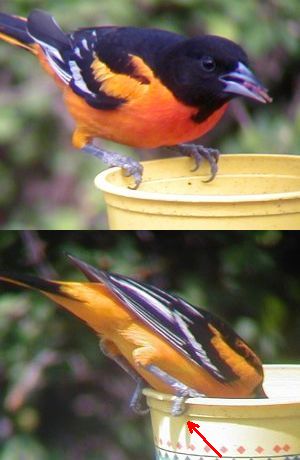
Let’s talk about toes.
We have five toes on each foot. Birds have four.
Our five toes point forward. Birds have three that point forward and one that points back(*).
We have a hallux — called a big toe — on each foot. The bird has a hallux on each foot too. It’s the toe that points back.
Here a Baltimore oriole is using his toes to perch on the edge of a jelly container. In the first photo it looks like he’s fine with only his front three toes, but in the second you can tell that without his halluces (red arrow) he’d fall into the dish!
If our big toes pointed backward we’d be able to perch on edges too — but then we couldn’t wear shoes.
(* Note: Osprey feet have three toes that point forward and a hallux that points back but osprey can rotate their outer toes backward. This makes a two-toes-front-two-toes-back arrangement that helps them carry fish.)
p.s. See the comments below for more birds who have two-and-two toes.
(photo by Marcy Cunkelman of a Baltimore oriole diving into her jelly container to get a snack)
This is just so interesting. I don’t think I’ll ever look at birds quite the same. I am not allowed to feed from my deck any more. Now 3 people have dishes up on roof & they complain that the birds perch there when I have a feeder & it interfers with the reception. And they don’t like the “pooH”. I should tell them they should be glad they are not falcon babies who shoot it out!!! But its amazing they still visit me. Must have a memory there that I was stop on the feeder list. But I still have a grosbeak who come & the finches & the other pretty ones, even a robin who didnt even eat from a feeder. But they look in the full sliding door & I certainly do apologize to everyone of them. Makes me cry. But I know there are alotof people with yards around that have feeders. I always check them out. There is one lady who just feeds finches & humming birds. Lovely picture as I walk by. Thanks for sharing your wonderful knowledge about the most wonderful creatures. Just aching for those who live in Louisiana water & wet lands.
I saw small feeders that attached to glass windows on a hospital windows – so the patients could see the birds. This is in Wicjenburg Az and hummingbirds were feeding— DONT GIVE UP YOUR JOY !
Parrots have two toes in the front and two in the back. It helps them perch, tightly grasp objects and hang upside down by one toe!
Aha! I didn’t remember this about parrots. Thanks, Diane.
I had no idea that ospreys were so talented. Fascinating! I have really enjoyed your anatomy lessons. Thanks for posting on such informative topics!
Along with parrots, birds from the family Trogonidae also have a two in front, two in back configuration, but it’s different from parrots because the toes are in different order.
Apparently peregrines have patterns on their middle toes that might be as unique as fingerprints. I found this statement on Birds of North America Online: “A sample of 90 peregrines had distinctive toe-scale patterns on middle toe that allowed for individual identification.”
Woodpeckers have the “two toes forward, two toes back” conformation as well, to help them grip tree bark and hang upside-down when they need to.
Birds with X-shaped feet as Kate described them (toes #2 & 3 in front and #1 & 4 in back) are called zygodactyl. (I remembered that for years because it’s such a fun word to say. “Zygodactyl!”) The Trogonidae feet Robin mentioned are called heterodactyl, because of the different toe arrangement (1,2 / 3,4).
Oh — and the usual arrangement, with the hallux (1) in back and toes 2, 3 and 4 in front is called “Anisodactyl”. I don’t know why!